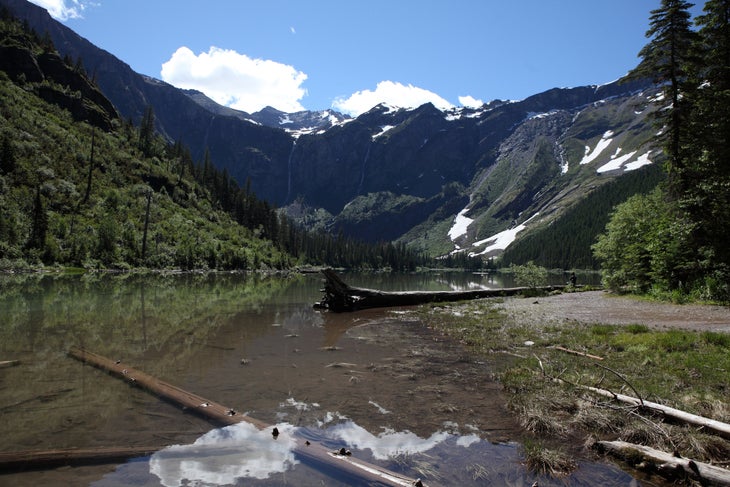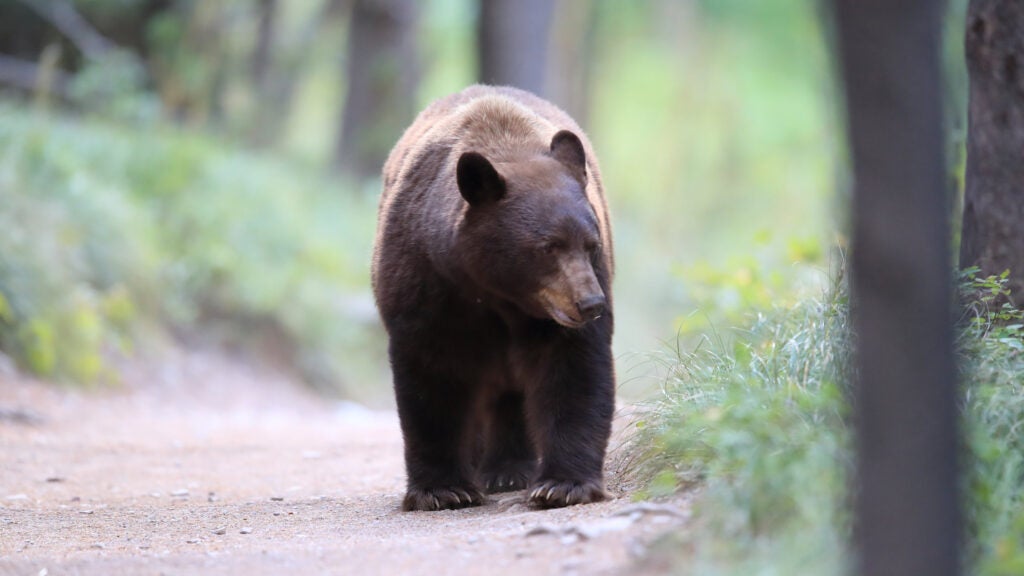Products You May Like
Heading out the door? Read this article on the new Outside+ app available now on iOS devices for members!
Download the app.
Randy had not planned on lying down in the middle of the trail that day. But there he was, clutching his now-dead flashlight. His face and neck were covered with dried black blood, flies buzzing around. He smelled bad, and the swelling in his face had narrowed his eyes to tiny slits. He looked, well, dead. After he realized I was there, looking down at him, he managed to put a few halting, puzzling words together.
“Don’t go in there! There’s a bear. It’s his home. He lives there…”
Just moments before, I had been absorbed in the numbing, foot-over-foot trudge up the steep trail, eyes focused on my boot laces. I almost walked right over him.
I ditched my large pack, helped him to his feet, and together we stumbled downhill to the trailhead, just a quarter-mile away. As I stopped to let him rest, Randy explained that he had been camping at Lincoln Lake when a black bear mauled him. He had hiked all night, slowly and painfully putting distance between him and the campground. Eventually, Randy said he could hear cars on the road down below, could even make out some flashes of headlights through the trees as they passed by in the early morning darkness. But he could go no further, so he lay down, facing the dark sky. Spent.
It was 1972, and I was working as a ranger in Glacier National Park. I had left the trailhead early to beat the July heat that day, destination Lincoln Lake. Over the previous weeks my partner and I had knocked off the seasonal evaluations of all the other backcountry campsites in our district. I drew the short straw for Lincoln Lake—“Stinkin’ Lincoln”, as it was dubbed, because getting there required a singularly boring 8.8-mile one-way hike.
I did not have a radio to call headquarters to report Randy’s predicament, so I drove him to the district office. Back then, there was no ambulance service that responded to park medical calls, so we folded Randy into Ranger Dave Haet’s patrol car and drove him to the nearest hospital in Whitefish.
There, Randy became a kind of celebrity. After all, it’s not very common for any emergency department in North America to admit a bear mauling victim. Soon, all kinds of healthcare personnel were swooping into the room, taking measurements, snapping photographs, asking questions, administering drugs, and suturing wounds with an almost giddy fascination. We obtained enough details from Randy for our report and left, leaving behind a small knot of folks: hospital counselors, ER docs, the grievance pastor, social service officials and other assorted lookie-loos clustered around Randy’s gurney. Word spreads quickly through the halls of a small local hospital.
The next day, Ranger Dave Shea and I took two horses and a mule into Lincoln Lake to examine the campsite and pack out Randy’s stuff. Upon arriving, we could see what had happened with perfect clarity. True to Randy’s story, a black bear had collapsed his tent in the early morning hours and had chased him up a tree, seizing his legs and pulling him down. He fell through the branches and onto the side of his face, breaking his nose, causing his teeth to take a chunk out of his tongue, and fracturing an orbital socket and a cheek bone. Despite the gashes and puncture wounds on his feet and lower legs where the bear had bitten him, he managed to thrust his bare feet into his boots, grab a large D cell flashlight, and fled down the trail. He hiked all night. At little creeks, he filled the lens cavity of his flashlight with water to quench the thirst brought on by blood loss.

From the looks of things, the bear had stayed around quite some time and worked the camp over, consuming any food items and scattering gear everywhere. An unopened can of Spam, punctured with tooth marks, lay near the horse hitching post. Randy’s torn and rumpled backpack was underneath the food hanging cable, but nowhere did we see a rope that could have been used to suspend it.
“Geez. Guy didn’t even hang his pack”, Dave said, shaking his head and scanning the carnage. He stood there for several moments, hands on his hips, and took in the crumpled food containers lying all around: a torn-up raisin box, granola wrappers, pieces of freeze-dried food bags. “Don’t camp dirty,” Dave muttered under his breath, a phrase all of us rangers used to tell backpackers entering bear country.
We found Randy’s shredded sleeping bag in a nearby alder patch, the white feathers scattered around it like a miniature blizzard. Back near the outlet creek at the foot of the lake, we saw telltale black bear tracks in the mud. And a scat: Using a small stick, we dissected it and found broken chunks of a plastic spoon and a wad of a Tillamook Swiss cheese wrapper. At the campsite, it was clear where the bear had climbed up a large spruce after Randy, scattering freshly-broken branches around the base of the tree.
“Wow. Look at this”, Dave said as he handed his binoculars to me. “Bear went all the way up there! D’ya see that?” He pointed twenty-five feet up the tree, where claw marks scored the trunk.
In the day-to-day of working in a national park, it is easy to forget that raw nature can be very unforgiving. Back then, just like now, there was no room for poor decisions. In our ranger world we had a saying: “If bears are up to something, that’s news. When they are not up to something, that’s news too.” Folks in bear country cannot be too “bear aware”. Only two summers after Randy’s incident, I witnessed similar wounds on a visitor who self-reported at the West Entrance, his naked back looking like it had been riddled with buckshot. Puncture wounds and larger gashes in the muscle tissue peppered his shoulders and he sat there shivering with shock. After he went to the hospital, we inventoried his backpack and found a diary that contained this entry: “Go to visitor center. Find where most bears are.”
Much has changed, of course, in the past 50 years. Now we have bear spray, something that wouldn’t have been available to Randy in 1972. It is nearly impossible to travel into bear habitat without noting the now-widespread warnings about the risks of bear encounters on trailhead signs, social media alerts, in handouts at entrance stations and visitor centers, and on web sites. Glacier now requires visitors obtaining a wilderness camping permit to view a brief video describing proper camping etiquette. The park loans out free bear canisters and gives out plastic garbage sacks with food storage warnings plastered all over them. Because of efforts like these, incidents like Randy’s have declined.
What has not changed, however, is that bears, especially those habituated to human food sources, are opportunistic foragers who eat just about anything in the relentless task of preparing for hibernation. They live by their noses: As the old saying goes, when a leaf falls in the woods, the eagle sees it, the deer hears it and the bear smells it. So no matter how much education we provide to people, the bottom line is the same now as it was then: “Don’t camp dirty,”
Years later, I was sitting outside one of the park’s backcountry patrol cabins, drinking scotch with Jerry DeSanto, a sage old ranger that we all revered and who had himself once been a victim of a grizzly bear attack. We revisited the story about Randy’s encounter with the black bear that summer at Lincoln Lake. After reflecting for a moment, Jerry looked off to the distant ridgeline as if picturing the moment. Then, pouring another scotch, he said, “I guess when you stop to think about it, wilderness ain’t wilderness ‘less there’s somethin’ out there as kin gitcha.”
